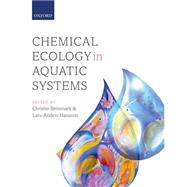Chemical Ecology in Aquatic Systems

Chemical Ecology in Aquatic Systems
- ISBN 13:
9780199583096
- ISBN 10:
0199583099
- Format: Hardcover
- Copyright: 05/04/2012
- Publisher: Oxford University Press
.svg) Rent
From $119.37
Rent
From $119.37
List Price $181.33 Save
| TERM | PRICE | DUE |
|---|---|---|



List Price $181.33 Save $1.81
Usually Ships in 3-5 Business Days
We Buy This Book Back!
Free Shipping On Every Order
Note: Supplemental materials are not guaranteed with Rental or Used book purchases.
Extend or Purchase Your Rental at Any Time
Need to keep your rental past your due date? At any time before your due date you can extend or purchase your rental through your account.
Summary
Chemical Ecology of Aquatic Systems covers a wide range of studies, both plant and animal, from different geographic regions and habitats - pelagic as well as benthic. Most of the chemical interactions are similar in freshwater and marine habitats and this book therefore strives at integrating work on both systems.






